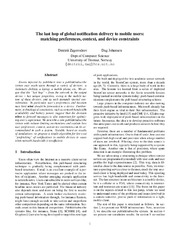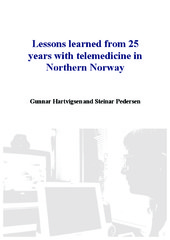Blar i tittel Artikler, rapporter og annet (informatikk)
Viser treff 170-189 av 389
-
K-CUSUM: Cluster Detection Mechanism in EDMON
(Journal article; Tidsskriftartikkel; Peer reviewed, 2019-11)The main goal of the EDMON (Electronic Disease Monitoring Network) project is to detect the spread of contagious diseases at the earliest possible moment, and potentially before people know that they have been infected. The results shall be visualized on real-time maps as well as presented in digital communication. In this paper, a hybrid of K-nearness Neighbor (KNN) and cumulative sum (CUSUM), known ... -
Kvasir-SEG: A Segmented Polyp Dataset
(Journal article; Tidsskriftartikkel; Peer reviewed, 2020-01-24)Pixel-wise image segmentation is a highly demanding task in medical-image analysis. In practice, it is difficult to find annotated medical images with corresponding segmentation masks. In this paper, we present Kvasir-SEG: an open-access dataset of gastrointestinal polyp images and corresponding segmentation masks, manually annotated by a medical doctor and then verified by an experienced ... -
Kvik: three-tier data exploration tools for flexible analysis of genomic data in epidemiological studies
(Journal article; Tidsskriftartikkel; Peer reviewed, 2015-03-30)Kvik is an open-source system that we developed for explorative analysis of functional genomics data from large epidemiological studies. Creating such studies requires a significant amount of time and resources. It is therefore usual to reuse the data from one study for several research projects. Often each project requires implementing new analysis code, integration with specific knowledge bases, ... -
Kvik: three-tier data exploration tools for flexible analysis of genomic data in epidemiological studies [version 1; peer review: 2 approved with reservations]
(Journal article; Tidsskriftartikkel; Peer reviewed, 2015-03-30)Kvik is an open-source system that we developed for explorative analysis of functional genomics data from large epidemiological studies. Creating such studies requires a significant amount of time and resources. It is therefore usual to reuse the data from one study for several research projects. Often each project requires implementing new analysis code, integration with specific knowledge bases, ... -
Label-free non-invasive classification of rice seeds using optical coherence tomography assisted with deep neural network
(Journal article; Tidsskriftartikkel; Peer reviewed, 2021-01-01)Identification of the seed varieties is essential in the quality control and high yield crop growth. The existing methods of varietal identification rely primarily on visual examination and DNA fingerprinting. Although the pattern of DNA fingerprinting allows precise classification of seed varieties but fraught with challenges such as low rate of polymorphism amongst closely related species, destructive ... -
The last hop of global notification delivery to mobile users. Matching preferences, context, and device constraints.
(Research report; Forskningsrapport, 2004)Events injected by publishers into a publish/subscribe system may reach users through a variety of devices: a stationary desktop, a laptop, a mobile phone, etc. We argue that the "last hop" -- from the network to the output device -- has unique properties, owing to the mobile nature of these devices, and as such demands special consideration. In particular, user's preferences and location may limit ... -
Lessons learned from 25 years with telemedicine in Northern Norway
(Book; Bok, 2015) -
LightLayers: Parameter Efficient Dense and Convolutional Layers for Image Classification
(Chapter; Bokkapittel, 2021-02-21)Deep Neural Networks (DNNs) have become the de-facto standard in computer vision, as well as in many other pattern recognition tasks. A key drawback of DNNs is that the training phase can be very computationally expensive. Organizations or individuals that cannot afford purchasing state-of-the-art hardware or tapping into cloud hosted infrastructures may face a long waiting time before the training ... -
Long-Term Engagement With a Mobile Self-Management System for People With Type 2 Diabetes
(Journal article; Tidsskriftartikkel; Peer reviewed, 2013-03-27) -
The Longcut Wide Area Network Emulator. Design and Evaluation
(Research report; Forskningsrapport, 2005)Experiments run on a Grid, consisting of clusters administered by multiple organizations connected by shared wide area networks (WANs), may not be reproducible. First, traffic on the WAN cannot be controlled. Second, allocating the same resources for subsequent experiments can be difficult. Longcut solves both problems by splitting a single cluster into several parts, and for each part having one ... -
Low-Cost Programmable Air Quality Sensor Kits in Science Education
(Chapter; Bokkapittel, 2018-02-21)We describe our citizen science approach and technologies designed to introduce students in upper secondary schools to computational thinking and engineering. Using an Arduino microcontroller and low-cost sensors we have developed the air:bit, a programmable sensor kit that students build and program to collect air quality data. In our course, students develop their own research questions regarding ... -
A low-cost set CRDT based on causal lengths
(Chapter; Bokkapittel, 2020-04)CRDTs, or Conflict-free Replicated Data Types, are data abstractions that guarantee convergence for replicated data. Set is one of the most fundamental and widely used data types. Existing general-purpose set CRDTs associate every element in the set with causal contexts as meta data. Manipulation of causal contexts can be complicated and costly. We present a new set CRDT, CLSet (causal-length set), ... -
A Low-Intensity Mobile Health Intervention With and Without Health Counseling for Persons With Type 2 Diabetes, Part 1: Baseline and Short-Term Results From a Randomized Controlled Trial in the Norwegian Part of RENEWING HEALTH
(Journal article; Tidsskriftartikkel; Peer reviewed, 2014-12-11) -
Mabnet: Master Assistant Buddy Network With Hybrid Learning for Image Retrieval
(Journal article; Tidsskriftartikkel; Peer reviewed, 2023-05-05)Image retrieval has garnered a growing interest in recent times. The current approaches are either supervised or self-supervised. These methods do not exploit the benefits of hybrid learning using both supervision and self-supervision. We present a novel Master Assistant Buddy Network (MAB-Net) for image retrieval which incorporates both the learning mechanisms. MABNet consists of master and assistant ... -
Machine Learning for Hydropower Scheduling: State of the Art and Future Research Directions
(Journal article; Tidsskriftartikkel; Peer reviewed, 2020-10-02)This paper investigates and discusses the current and future role of machine learning (ML) within the hydropower sector. An overview of the main applications of ML in the field of hydropower operations is presented to show the most common topics that have been addressed in the scientific literature in the last years. The objective is to provide recommendations for novel research directions that can ... -
Masking the Effects of Delays in Human-to-Human Remote Interaction
(Chapter; Bokkapittel, 2014)Humans can interact remotely with each other through computers. Systems supporting this include teleconferencing, games and virtual environments. There are delays from when a human does an action until it is reflected remotely. When delays are too large, they will result in inconsistencies in what the state of the interaction is as seen by each participant. The delays can be reduced, but they cannot ... -
Measuring Physical Activity with Sensors : A Qualitative Study
(Journal article; Tidsskriftartikkel; Peer reviewed, 2009) -
Meta-learning with implicit gradients in a few-shot setting for medical image segmentation
(Journal article; Tidsskriftartikkel; Peer reviewed, 2022-01-12)Widely used traditional supervised deep learning methods require a large number of training samples but often fail to generalize on unseen datasets. Therefore, a more general application of any trained model is quite limited for medical imaging for clinical practice. Using separately trained models for each unique lesion category or a unique patient population will require sufficiently large curated ... -
META-pipe cloud setup and execution
(Journal article; Tidsskriftartikkel; Peer reviewed, 2018-01-18)META-pipe is a complete service for the analysis of marine metagenomic data. It provides assembly of high-throughput sequence data, functional annotation of predicted genes, and taxonomic profiling. The functional annotation is computationally demanding and is therefore currently run on a high-performance computing cluster in Norway. However, additional compute resources are necessary to open the ... -
The metagenomic data life-cycle: standards and best practices
(Journal article; Tidsskriftartikkel; Peer reviewed, 2017-08-01)Metagenomics data analyses from independent studies can only be compared if the analysis workflows are described in a harmonized way. In this overview, we have mapped the landscape of data standards available for the description of essential steps in metagenomics: (i) material sampling, (ii) material sequencing, (iii) data analysis, and (iv) data archiving and publishing. Taking examples from marine ...


 English
English norsk
norsk


















